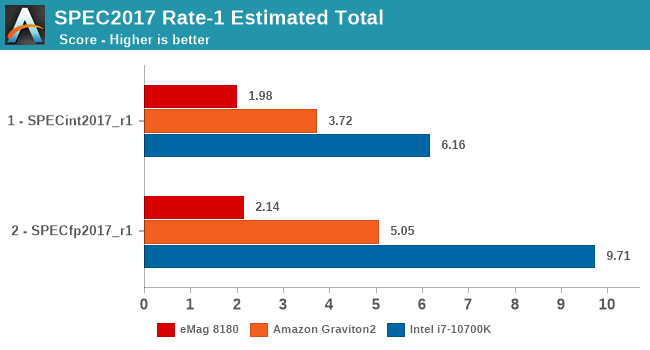Avantek's Arm Workstation: Ampere eMAG 8180 32-core Arm64 Review
by Andrei Frumusanu on May 22, 2020 8:00 AM ESTSPEC2017: Weak ST Performance
Single-threaded performance of the system is going to be interesting, but given the age of the CPUs we shouldn’t be expecting any miracles.
As comparison points, I’m adding the new Neoverse-N1 based Graviton2 results, which should server as an indicator what a contemporary Arm core should be able to achieve, as well as Intel’s i7-10700K (Equivalent to an 9900K) – a common mainstream consumer-grade CPU that should represent your higher-end x86 desktop machine.

Things aren’t looking too well for the Skylark cores, as performance isn’t really up to par with more recent generation hardware. There’s no specific workload in which the eMAG does badly in, but we do see that small memory footprint workloads such as 548.exchange2 aren’t faring all that badly – pointing out that for the other workloads the system must be cache and memory bottlenecked.

In the floating point suite, things are again not too great and performance further craters in some tests.

Overall, the eMAG 8180 is extremely disappointing in its single-threaded performance. It’s actually quite intriguing to see the results. Even though the Skylark cores are operating at 3.3GHz, the end performance isn’t any better than a 2.1GHz Cortex-A72 core such as found in the first-generation Graviton chip. That’s quite the massive IPC disadvantage even between those two older CPU microarchitectures, and reminds us of the reason AppliedMicro hadn’t really seen much success with its design.










35 Comments
View All Comments
vFunct - Friday, May 22, 2020 - link
They really need ARM systems that are a little higher than Raspberry-PI but a little lower than x86, perhaps in the $100-$200 price range, for personal network appliances.Death666Angel - Friday, May 22, 2020 - link
I'd be interested in what you would use that one for? And why exactly those specs? Lower power than x86 at "good enough" performance levels? If that is the base, why not do an undervolted / down clocked x86 build? Ryzen can get to some pretty great voltage/frequency levels. :D Or is it the ATX form factor as well? That one is a bit trickier, either go with a 12/19V native motherboard or get a nice pico PSU with ATX cables and a 12/19V input. :) Unless I'm way off base in my assumptions. :Dlmcd - Friday, May 22, 2020 - link
I haven't used an RPi 4 yet but I'd be willing to bet the 4GB variant would meet vFunct's needs.vFunct - Friday, May 22, 2020 - link
Network file server with ZFS, Or, a mail server.Need storage & memory, but don't need intense CPU
vFunct - Friday, May 22, 2020 - link
Network file server with ZFS, Or, a mail server.Need storage & memory, but don't need intense CPU.
Wilco1 - Friday, May 22, 2020 - link
It's worth pointing out for future reviews that GCC 10 is out and shows a 10.5% performance gain on Neoverse N1: https://community.arm.com/developer/tools-software...SarahKerrigan - Friday, May 22, 2020 - link
Doesn't mean much for eMag, though.Wilco1 - Saturday, May 23, 2020 - link
Indeed, eMag is quite old, so it won't benefit nearly as much as the latest microarchitectures.GreenReaper - Sunday, May 24, 2020 - link
The graph at the end suggests that 10.0 was a significant regression for many tests, though, so that should probably be taken with a pinch of salt. <^_^>There are some tests (mostly vectorization-related) where it's really helped, though.
mrvco - Friday, May 22, 2020 - link
Out of curiosity, how would the performance of the eMag compare to a typical single-board ARM computer? My reference point would be the RPi3 or 4, but there seem to be a variety of others ranging up to a couple hundred dollars with (allegedly) 'better' performance than the RPi.